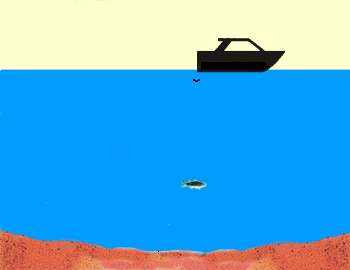How is sound used to locate fish?

Sonars send sound waves or signals into the water that rebound when they strike an object. The fish reflects some of the signal back to the boat, the remainder of the signal continues to the seafloor then it bounces back to the boat. (Courtesy of Lowrance Electronics, Inc.)
Some sonar systems are especially designed to locate fish. These systems use the same basic principle as other sonar systems – they transmit sound pulses, measure the time it takes for echoes to return, and calculate the distance to the objects. (See: How do people and animals use sound in the sea).
Fish finding sonar units send and receive signals many times per second. They concentrate sound into a beam that is transmitted from a transducer. These units include visual displays that print the echoes. The bottom appears as a continuous line drawn across the display. In addition, any objects that are in the water between the surface and the bottom may also be displayed.

Display of the Deep Sea Diver Fish Finder by Lowrance Electronics. (Courtesy of Lowrance Electronics, Inc.)
Fish finders detect the presence of fish primarily by detecting the air in their swim bladders. The air conserved in the swim bladder changes the sound path and reflects energy back. The fish finder detects this reflected energy and converts it into fish images on the screen.
Fish finders operate at high frequencies of sound, approximately 20-200 kHz (20-200,000 cycles per second). This helps define targets and can even display two fish as two separate echoes or arches. (See How is sound used to identify fish?). Lower frequencies (i.e. 50 kHz) can penetrate deeper waters but may not be able to define individual targets. Putting more energy into the pulse sent out by the transducer increases the probability of getting a signal to return in deeper water.
Images are formed on the visual display as arches due to the movement of the boat or the fish. When sound is transmitted from the transducer it is concentrated into a beam. As the sound passes into deeper water, the beam spreads out and covers a wider area. If the transmitted sound were plotted, it would look like a traffic cone with a pointed top and a broad base.

Sound transmitted from the boat’s transducer spreads out in a conical shape. (Courtesy of Lowrance Electronics, Inc.)
Fish that swim within this cone may reflect some of the sound back to the transducer. The reflected sound, or echo, appears on the sonar’s chart display. A school of fish will appear as many different shapes or formations, depending on how much of the school is within the transducer’s cone. Individual fish, especially those in deeper water, may appear as arches on the display. The following illustrations demonstrate how a fish arch forms as the fish moves through the sonar beam.

Example of how an arch is formed as a fish passes through the sonar beam. Courtesy of Lowrance Electronics, Inc.
A fish arch forms as the fish moves through the sonar beam. A mark appears on the chart display (on right) when the fish enters the outer edge of the cone. As the fish swims through the cone, the distance between the transducer and the fish decreases, and the mark begins to curve up. When the fish is at the center of the beam it is directly beneath the transducer. The mark begins to flatten out as the fish reaches its closest point to the transducer. As the fish continues to move through the beam to the opposite end of the cone, the distance increases. The mark begins to curve downward because the fish is moving further and further away from the transducer. An arched mark appears as the chart display graphs this distance change.
Additional Links on DOSITS
Additional Resources
- Boat U.S. Presents Chuck Husick – Fish Finders.
- Lowrance Electronics Inc – Sonar Tutorial: Fish Arches.
- Lowrance Electronics, Inc. – Sonar Tutorial.
- Mr. Wizard Predicts Future for Fish Finders.
- The Ultimate Bass Fishing Resource Guide – Get Serious About Sonar.